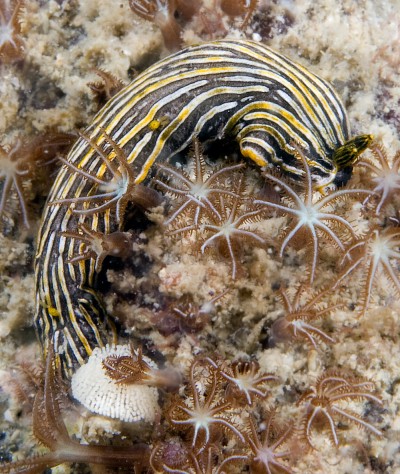
Dermatobranchus sp. 9
Order: NUDIBRANCHIA
Suborder: ARMININA
Family: Arminidae
PHOTO
Upper Photo: Koh Hu Chang, Pattaya, Chonburi Province, Thailand, Gulf of Thailand, 6 metres, Length: 25 mm. 24 January 2010. Photographer: Lawrence Neal.
This animal has a black background colour and white longitudinal ridges on the mantle, each with a thin yellow line down the midline. Its association with stoloniferous octocorals strongly suggests that it is a species of Dermatobranchus.
This species has similarities to an animal Baba identified as Dermatobranchus striatus (van Hasselt, 1824) [see message #23319].
Authorship detailsRudman, W.B., 2010 (March 11) Dermatobranchus sp. 9 [In] Sea Slug Forum. Australian Museum, Sydney. Available from http://www.seaslugforum.net/find/dermsp9
Related messages
Re: Dermatobranchus striatus ? from the Gulf of Thailand
March 11, 2010
From: Bill Rudman
Concerning message #23319:
Dear Lawrence
I just remembered there is a freely available pdf of Bergh's 1887 paper on van Hasselt's opisthobranchs. It is includes a colour plate with a not very useful illustration of Dermatobranchus striatus. The pdf is of the whole volume of the Notes from the Leyden Museum. The Bergh paper is right at the end of the volume. The plate is with the other plates for the volume after the index.
http://www.archive.org/details/notesfromleydenm09rijk
- BERGH, L. S. R. 1887 Note XLIII. Die Van Hasselt'schen Nudibranchien. Notes from the Leyden Museum 9(4):303-323, pl. 6.
Best wishes
Bill Rudman
Rudman, W.B., 2010 (Mar 11) Re: Dermatobranchus striatus ? from the Gulf of Thailand. [Message in] Sea Slug Forum. Australian Museum, Sydney. Available from http://www.seaslugforum.net/find/23330Dermatobranchus striatus ? from the Gulf of Thailand
March 11, 2010
From: Lawrence Neal
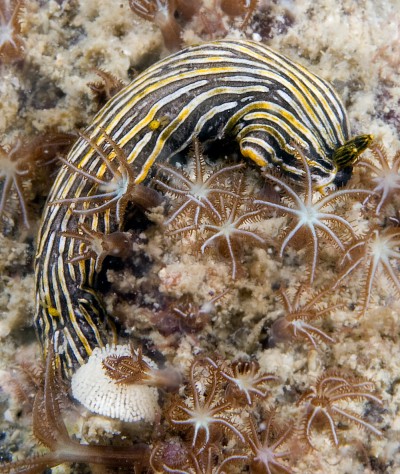
Dear Bill,
Here are some photos of what I believe is Dermatobranchus striatus (van Hasselt, 1824) from different parts of the Gulf of Thailand.
Upper Photo: Koh Hu Chang, Pattaya, Chonburi Province, Thailand, Gulf of Thailand, 6 metres, Length: 25 mm. 24 January 2010. Middle left photo: closeups from upper photo showing mantle and yellow copepod. Middle right Photo: Koh Yippon, Angthong Marine Park, Surat Thani Province, Thailand, Gulf of Thailand, 13 metres. Length: 30 mm. 5 July 2009. Lower Photo: Koh Rin, Pattaya, 12 metres, Chonburi province, Thailand, Gulf of Thailand, 12 October 2008, Hard coral reef. Length: 20 mm. Photographer: Lawrence Neal.
I don't have a copy of van Hasselt's original description from Indonesia but a redescription by Baba based on individuals collected from Okinawa (25 mm and 35 mm alive) gives the following description:
"The body can be greatly extended or shortened according to the movement of the animal The head veil (or oral veil) is smooth. The back is provided with numerous fine longitudinal folds or ridges. Both sides of the body are entirely smooth
"The main colour features of this species are the following: (1) Dorsally the head veil is black-brown with transverse white lines. (2) The ground colour of the back is also black-brown. Each of the longitudinal ridges bears a white line on its crest, forming white ovoid patches at some places. (3) The rhinophores are deep yellow apically, black-brown on the clubs and colourless on the stalks. (4) The extreme edges of the head veil, mantle and foot are bordered with a narrow yellow line. The sides of the body and the foot sole are white."
The photographed individuals from Thailand seem to correspond quite well with this description and with the drawings in Baba's paper, although most individuals from Thailand seem to have varying amounts of yellow within the white lines of the longitudinal ridges. The black semi-circular marking on the dorsal oral veil seems to be characteristic.
From the information I can glean, current geographical range is Indonesia, Japan, Papua New Guinea and the Gulf of Thailand.
This species is quite common at many sites in the Gulf of Thailand, usually found in association with its prey food: mat-forming stoloniferous octocorals which cover rocks in reef areas. I understand the octocoral is a species of Briareum (previously Polyclavularia??). Individuals are often infested with bright yellow copepod parasites.
Interestingly, a similar species, Dermatobranchus albus, is present in the Andaman Sea off Western Thailand and feeds on a very similar (but not identical) species of Briareum. To date, I have never come across (or heard of) D. striatus in the Andaman Sea, nor D. albus in the Gulf of Thailand.
I feel fairly certain that the nudibranch in message #2921 listed as Armina cf. japonica is also this species, taking into consideration its appearance, size, location and the presence of the same octocoral in the photograph.
- Baba, K. (1992) Critical Review of Dermatobranchus striatus van Hasselt, 1824 (Nudibranchia: Arminidae) with the Description of a New Species. Japanese Journal of Malacology Vol. 53, No. 4 (1992): 239-248
Best wishes,
Lawrence
lorenzo_n@yahoo.com

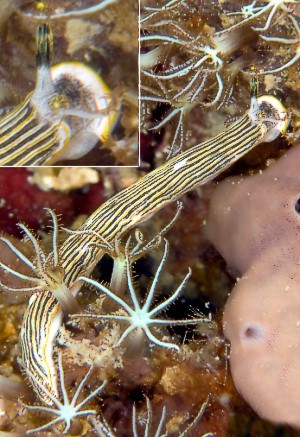
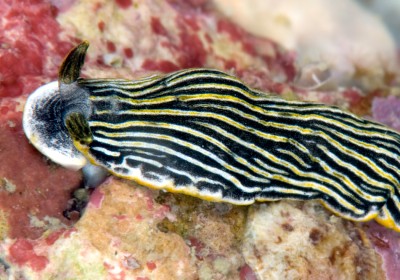
Dear Lawrence,
Your message is interesting on many fronts. First its identity. I agree with you that it is almost certainly the same as the animal I have 'labelled' as Armina cf. japonica. As I query in my reply to that message I am uncertain if it is a species of Armina or of Dermatobranchus but noted a likeness to Armina japonica [see also Kathe Jensen's message [#2957]] It is difficult to separate species of Armina and Dermatobranchus just from photos, but your observation of the animals always associating with stoloniferous octocorals is a good clue that they are indeed a species of Dermatobranchus as species of Armina as usually found feeding on sea pens.
Concerning what species it is. I have my doubts whether Baba's animal is the same as van Hasselt's and am not sure we can ever be sure. There are quite a few species of Dermatobranchus with white ridges on a black background many of which seem to be unnamed. Your animal differs from Baba's in the distinctive yellow line long each white ridge and the colour of the rhinophores. This may seem minor but it may reflect major internal differences. Chromodorids are not the only group in which small colour pattern differences can be highly significant. We also have little idea of colour variation within a species. Just in your photos we can see that the head can be edged in yellow but in some animals they yellow is absent.
For that reason I prefer to leave this species as Dermatobranchus sp. 9 rather than confuse the issue by having a number of potentially different species all labelled as one.
I also noticed a couple of the yellow copepods on one of your animals which I have added a close-up of, and also a closeup of what could well be an egg ribbon of this species. The size of the eggs suggest they belong to an animal with abbreviated larval development. It would be interesting to keep a few egg ribbons in an aquarium and see if the larvae hatch out as crawling young slugs rather than as swimming veliger larvae.
Best wishes,
Bill Rudman
Re: Armina cf. japonica from Thailand
September 1, 2000
From: Kathe R. Jensen
Note added 11 March 2010: This is now considered a species of Dermatobranchus. [See message #23319]
Dear Bill,
You tentatively assigned this species of Armina to A. japonica, provided it does not have papillae on the head veil. Some years ago I described the anatomy of some species of Armina from Hong Kong. One was a black and yellow striped species with papillae on the head veil. This I identified as Armina comta (Bergh, 1880). It is also the species figured in Orr, J. (1981) Hong Kong Nudibranchs. Possibly it is also the one figured in Debelius' book.
Reference: Jensen, K.R. (1997) The Arminidae (Mollusca: Opisthobranchia) of Hong Kong. Pp. 159-187 in: The Marine Flora and Fauna of Hong Kong and Southern China IV (ed. B. Morton). Hong Kong University Press.
Regards,
Kathe
jensen@ait.ac.th
Jensen, K.R., 2000 (Sep 1) Re: Armina cf. japonica from Thailand. [Message in] Sea Slug Forum. Australian Museum, Sydney. Available from http://www.seaslugforum.net/find/2957Thanks Kathe,
Bill Rudman.
Armina cf. japonica from Thailand
August 31, 2000
From: Narongpon Sittithaweepat
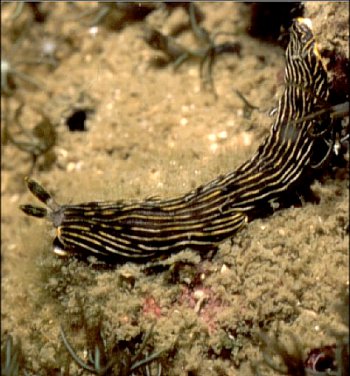
Note added 11 March 2010: This is now considered a species of Dermatobranchus. [See message #23319]
Dear Bill
This specimen is Armina sp. I found it in 50-60 feet at Chomporn, Thailand . Its size is 3.5 cm. So could you please identify it for me.
Thank you
Narongpon
ning@talaythai.com
Sittithaweepat, S., 2000 (Aug 31) Armina cf. japonica from Thailand. [Message in] Sea Slug Forum. Australian Museum, Sydney. Available from http://www.seaslugforum.net/find/2921Dear Narongpon,
There are many species of Armina and Dermatobranchus which are in need of investigation. This animal looks very like the species Baba (1949) identified as Armina japonica (Eliot, 1913). Debelius identifies another species from Sydney Harbour as Armina japonica and states that the papillae on the oral veil are characteristic which is in direct contradiction to Baba's "head veil smooth above". Eliot's original description also mentions a smooth oral veil so I don't think Debelius is correct.
Are you sure it is an Armina and not Dermatobranchus?
Best wishes,
Bill Rudman.
